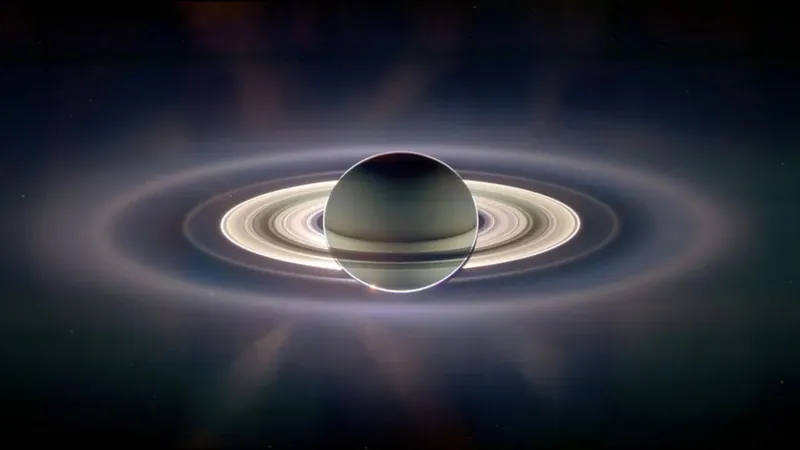
Why Saturn Outshined Jupiter in the Battle for Moons: The Amazing Discovery of Tiny Satellites!
2025-04-05
Author: Daniel
The Quest for Discovering New Moons
The quest for discovering new moons or planets is an astronomical adventure filled with challenges. It's not simply about capturing a single image; researchers must take sequential photos and meticulously align them to compensate for the movement of these celestial bodies. This elaborate process allows astronomers to reveal objects that could easily be lost in the cosmic haze—imagine trying to spot the flicker of candles on the Moon from Earth! This painstaking study often spans years, as researchers strive to uncover the mysteries of our solar system.
Saturn's Remarkable Collection of Tiny Moons
Recently, Saturn has snagged the spotlight by boasting a remarkable collection of tiny moons, vastly different from the familiar sight of our own Moon. These miniature satellites are only a few kilometers in diameter, a stark contrast to our Moon's impressive radius of 1,737 kilometers. This abundance of small moons speaks volumes about the intense and chaotic environment surrounding Saturn, which now surpasses Jupiter's previous record of 95 moons—totaling a staggering 274 moons for the ringed giant!
Dynamics of Moon Formation
Many of these newly identified moons appear to be born from violent collisions between larger celestial bodies, suggesting a dynamic history filled with chaos. The collisions likely involved larger objects several kilometers across, giving rise to groups of clustered satellites that share a common origin. These events are believed to have occurred relatively recently, around 100 million years ago—a mere blink in the cosmic timeline of 4.65 billion years.
Saturn's Icy Surroundings
Excitingly, it's possible that some of these collisions happened in remote corners of the solar system, with debris from these impacts getting captured by Saturn's powerful gravitational field. Positioned farther from the Sun than Jupiter, Saturn navigates a region dense with icy objects, making it plausible that it has accumulated assorted fragments that contributed to its burgeoning moon collection. Icy bodies, being less durable compared to the rocky satellites of Jupiter, could explain why Saturn seems to be winning this lunar race.
Orbital Advantage
Another factor that plays in Saturn's favor is the advantageous placement of its orbit. As Saturn recently moved into a region of the sky with fewer stars in the backdrop, astronomers found it easier to detect the faint signals of these tiny moons. Unlike Jupiter, which is closer and thus appears to dominate a wider space due to its gravitational pull, studying the vast expanse around Saturn presents less hindrance, facilitating the discovery process.
Future of Moon Discoveries
While it may seem daunting for Jupiter to catch up with Saturn's impressive lunar tally, the field of astronomy is ever-evolving. This recent find is sure to spur further investigations into the celestial dynamics at play among giant planets, as theorists dive into research regarding how these planets formed and accumulated their moon collections over eons. Observers will continue their vigilant scanning of the skies, hoping to uncover even fainter objects that orbit these majestic giants.
Conclusion
Ultimately, the ongoing discoveries challenge our understanding of the solar system and its formation processes, leaving us excited for what might be discovered next. Will Jupiter rise in the ranks, or will Saturn maintain its crown as the true Moon King? Stay tuned as we unravel more secrets of the universe!


 Brasil (PT)
Brasil (PT)
 Canada (EN)
Canada (EN)
 Chile (ES)
Chile (ES)
 Česko (CS)
Česko (CS)
 대한민국 (KO)
대한민국 (KO)
 España (ES)
España (ES)
 France (FR)
France (FR)
 Hong Kong (EN)
Hong Kong (EN)
 Italia (IT)
Italia (IT)
 日本 (JA)
日本 (JA)
 Magyarország (HU)
Magyarország (HU)
 Norge (NO)
Norge (NO)
 Polska (PL)
Polska (PL)
 Schweiz (DE)
Schweiz (DE)
 Singapore (EN)
Singapore (EN)
 Sverige (SV)
Sverige (SV)
 Suomi (FI)
Suomi (FI)
 Türkiye (TR)
Türkiye (TR)
 الإمارات العربية المتحدة (AR)
الإمارات العربية المتحدة (AR)